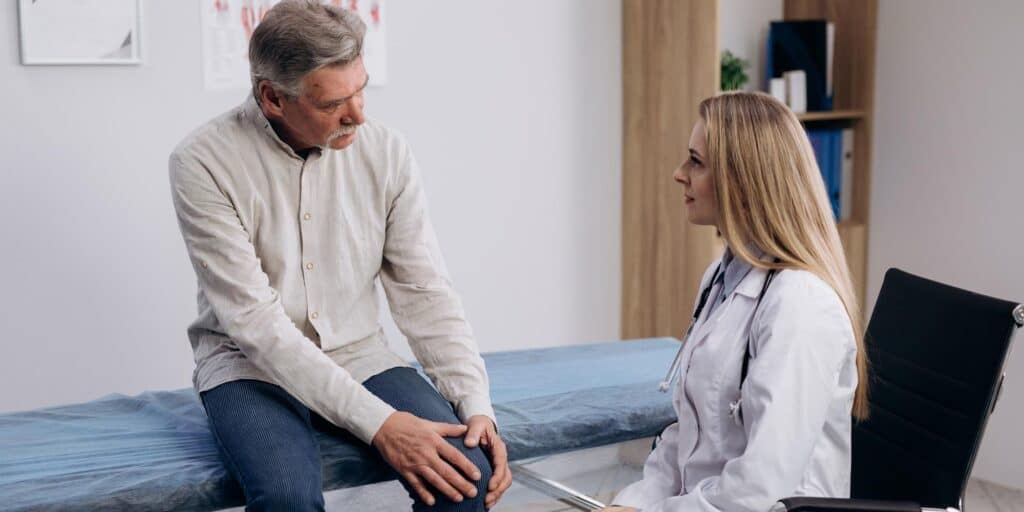If you struggle with frequent, uncontrollable urges to move or stretch your legs, you might think you’re experiencing muscle spasms or the occasional bout with stress. However, if these urges persist, and are accompanied by unpleasant sensations in your legs, you may have a chronic neurological condition called restless legs syndrome.
Restless legs syndrome is one of several chronic disorders that can cause exhaustion and daytime sleepiness, which can negatively affect mood, concentration, job and school performance, and personal relationships.
To better understand restless legs syndrome, what causes it, and what symptoms it can cause, we’ve put together everything you need to know about this common condition. First, let’s start by understanding what restless legs syndrome is, and what causes it.
What Is Restless Legs Syndrome?
Restless legs syndrome (RLS), also known as Willis-Ekbom disease, is a neurological disorder that causes unpleasant sensations in the legs. These sensations are also accompanied by powerful, often irresistible urges to move the legs, which is where the condition gets its name. For most people with RLS, these unusual sensations often occur when your body is relaxed, or when you are trying to sleep.
It’s estimated that about 10 percent of Americans, roughly 30 million people, are currently living with RLS. While the condition can affect anyone, it is more common in women than in men. Many individuals who are severely affected are middle-aged or older, and the symptoms typically become more frequent and last longer with age.
The most serious concern for those living with RLS is sleep. The constant urge to move the legs, along with the unpleasant sensations, can interfere with sleep, causing daytime sleepiness and chronic fatigue.
Nearly 80 percent of people with RLS have a related condition known as periodic limb movement of sleep (PLMS). PLMS causes the legs to jerk or twitch during sleep. For some, these involuntary twitches can occur as often as every 15 seconds and can continue throughout the night. PLMS can also lead to sleep deprivation, which can have a host of negative side effects.
While there is no cure for RLS, with the right medications and treatment approach you can better manage your symptoms, and live a more fulfilling life.
What Causes Restless Legs Syndrome?
Like many other neurological disorders, the exact cause of RLS remains a mystery. Researchers believe that the condition may be caused by a combination of environmental and genetic factors.
One of the leading theories as to what causes RLS is genetics. This means that parents with RLS can pass the condition to their children. In cases where the condition has no known cause (idiopathic), some studies have found that as many as 92 percent of people with RLS have a first-degree relative with the condition.
In addition to genetics, several medical conditions are closely associated with the development of RLS. These include:
- Low iron levels (iron deficiency)
- Hypothyroidism
- Depression
- Fibromyalgia
- Parkinson’s disease
- Kidney disease
- Diabetes
- Rheumatoid arthritis
- Peripheral neuropathy
- Pregnancy
Certain medications can also contribute to the onset of restless leg syndrome. Most notably, these medications include antidepressants, allergy medications, and anti-nausea medications. Caffeine, nicotine, and alcohol can also make symptoms of RLS worse.
Symptoms of Restless Legs Syndrome

If you believe that you have RLS, you may be wondering how you can tell. The most prominent symptom of RLS is the overwhelming, uncontrollable urge to move your legs. This feeling is most often during times of relaxation, such as when you are trying to sleep or while sitting still. You may also experience feelings of tingling, crawling, or pulling in your legs, which are usually relieved by moving your legs.
More mild forms of RLS may not cause nightly symptoms. You may even attribute these sensations or movements to restlessness, stress, or nervousness. More severe cases of RLS, however, are much harder to ignore. These symptoms can complicate even the simplest of activities, such as watching television or driving a car.
Symptoms of RLS often involve both sides of the body, although some people may experience symptoms more in one leg than the other. People with RLS often have difficulty falling asleep or staying asleep. This can often lead to symptoms such as excessive daytime sleepiness, fatigue, sleep deprivation, and mental fog.
People with RLS often will use movement as a way to relieve their symptoms. This may mean getting up and walking around, tossing and turning in bed, or stretching their legs frequently.
Who Is At Risk for Restless Legs Syndrome?
While the exact cause of RLS remains unknown, there are a handful of things that may put you at higher risk. However, it is important to note that while these risk factors may increase your risk, it is uncertain if any of these directly cause the onset of RLS.
Some of these risk factors include:
- Age: While RLS can occur at any age, it is more common, and more severe, after middle age.
- Gender: While still unclear as to the cause, women appear to be twice as likely to develop RLS than men.
- Family history: You are more likely to develop RLS if you have a close family member who has the condition.
- Pregnancy: Some individuals who become pregnant also develop RLS, particularly in the last trimester. Typically, this subsides within a few weeks after giving birth.
- Chronic conditions: Certain chronic conditions, such as fibromyalgia, may lead to RLS. Oftentimes, treating these conditions may relieve your symptoms.
- Ethnicity: Anyone can develop RLS, however, it appears to be more common among people of Northern European descent.
Treating Restless Legs Syndrome


As previously mentioned, there is currently no known cure for RLS. Treatment for RLS largely depends on the intensity and frequency of your symptoms. You should consider treatment for RLS if your quality of life is affected by insomnia or chronic fatigue. If your RLS is believed to be the cause of an ongoing medical condition, you may want to talk with your doctor about specific, targeted treatments.
Non-Drug Treatments
If you wish to treat your RLS without the use of medications, there are several non-drug treatments available. These include:
- Regular exercise: Getting regular exercise, such as walking or riding a bike, but avoiding heavy, intense exercise is thought to help with RLS symptoms.
- Practicing proper sleep habits: Since RLS can interfere with your sleep schedule, practicing proper sleep habits can help you get a more sound night’s sleep. Avoid watching television or being on your phone before bed, and try to aim for seven to nine hours of sleep every night.
- Limiting caffeine intake: Caffeinated products, as well as products containing nicotine or alcohol, are both believed to intensify RLS symptoms.
- Heating pads and cold compresses: Applying a heating pad, cold compress, or rubbing your legs to provide temporary relief to the leg discomfort. You may also find that alternative treatments such as acupuncture or light stretching may help relieve RLS symptoms.
Medications
Should your doctor recommend medications, there are a few routes you may consider. These include:
- Dopamine agonists: These medications can help control the urge to move, and unpleasant sensations in the legs, and reduce involuntary movements during your sleep. Some common FDA-approved dopamine agonists include Ropinirole (Requip®), pramipexole (Mirapex®), and the rotigotine patch (Neupro®).
- Anti-seizure medications: Certain anti-seizure medications can help slow or block pain signals from nerves in the legs. These drugs are particularly effective in patients with painful RLS due to neuropathy. Examples include gabapentin enacarbil (Horizant®), gabapentin (Neurontin®), and pregabalin (Lyrica®)
- Benzodiazepines: Benzodiazepines, mainly clonazepam (Klonopin®), are sometimes prescribed to patients with RLS. This type of medication is usually reserved for very severe cases of RLS due to its addictive nature and side effects.
- Opioids: Similar to benzodiazepines, opioids such as methadone or oxycodone can be used to relieve pain from severe cases of RLS, but are usually not prescribed due to their addictive potential.
You and your doctor will discuss the treatment that might be best for you.
Are You Living With Restless Legs Syndrome?
Share your experiences in the comments below!
What topics related to restless legs syndrome should we cover next?
Email us your ideas at info@painresource.com!
Looking for more resources on restless legs syndrome?
Join the Pain Resource Community today to start connecting with thousands of people with chronic conditions. Joining is free, easy, and gives you access to exclusive content and giveaways! Join today by clicking here!




